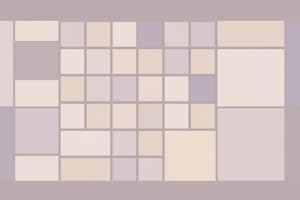Podcast
Questions and Answers
What is the formula for calculating the area of a triangle?
What is the formula for calculating the area of a triangle?
- A = 2 au r
- A = rac{1}{2}bh (correct)
- A = s^2
- A = lw
How is the area of a square determined?
How is the area of a square determined?
- A = lw
- A = rac{1}{2}bh
- A = 2 au r
- A = s^2 (correct)
Which formula is used to find the area of a rectangle?
Which formula is used to find the area of a rectangle?
- A = lw (correct)
- A = rac{1}{2}bh
- A = s^2
- A = 2 au r
What property distinguishes a square from other rectangles?
What property distinguishes a square from other rectangles?
In a circle, what is equidistant from the center?
In a circle, what is equidistant from the center?
What does 'h' represent in the formula for the area of a triangle?
What does 'h' represent in the formula for the area of a triangle?
What does 'l' represent in the formula for the area of a rectangle?
What does 'l' represent in the formula for the area of a rectangle?
Which shape's area can be determined by multiplying its perimeter by half the apothem?
Which shape's area can be determined by multiplying its perimeter by half the apothem?
What characterizes a rectangle's opposite sides?
What characterizes a rectangle's opposite sides?
Which of the following shapes has every point on its edge equidistant from its center?
Which of the following shapes has every point on its edge equidistant from its center?
Flashcards
Area of a Triangle
Area of a Triangle
A polygon with three sides. Area = 1/2 * base * height.
Area of a Square
Area of a Square
A quadrilateral with all four sides equal. Area = side * side.
Area of a Rectangle
Area of a Rectangle
A quadrilateral with opposite sides equal. Area = length * width
Area of a Circle
Area of a Circle
Signup and view all the flashcards
Height of a Triangle
Height of a Triangle
Signup and view all the flashcards
Radius of a Circle
Radius of a Circle
Signup and view all the flashcards
Study Notes
Exploring Area in Plane Figures
In the vast landscape of shapes, the notion of area is a fundamental concept that helps us understand and compare the size of plane figures. As we delve into the realm of triangles, squares, rectangles, and circles, let's unravel their unique formulas for calculating their respective areas.
Area of Triangles
A triangle is a polygon with three sides and three interior angles. Its area can be calculated using the formula:
[A = \frac{1}{2}bh]
Where (b) is the base, and (h) is the height (also known as altitude) orthogonal to the base. This method provides a straightforward, reliable, and intuitive way to find the area of a triangle.
Area of Squares
A square is a special type of rectangle with all four sides equal in length. As a result, its area can be calculated by squaring the length of one side:
[A = s^2]
Where (s) is the side length. This simplicity allows us to determine the area of squares without any complex calculations.
Area of Rectangles
Rectangles are another type of quadrilateral with opposite sides equal in length. The area of a rectangle can be calculated with the formula:
[A = lw]
Where (l) is the length and (w) is the width. This formula helps us understand the relationship between the length and width of a rectangle, and the size of its area.
Area of Circles
A circle is a two-dimensional shape with every point on its edge equidistant from its center. The area of a circle can be calculated using the formula:
[A = \pi r^2]
Where (r) is the radius of the circle. This formula is more complex than those of other shapes but is still relatively straightforward.
By understanding these formulas, we can accurately determine the area of different plane figures and appreciate their relationships. For example, the area of a square is always equal to the area of a circle with the same radius, as the radius of the circle squared is equal to the side length of the square squared.
These formulas are helpful for a wide range of applications, from calculating the area of a roof or a field to finding the best way to fit a given area with different shapes. With practice, we can become adept at using these methods and unleash their limitless potential.
Studying That Suits You
Use AI to generate personalized quizzes and flashcards to suit your learning preferences.




